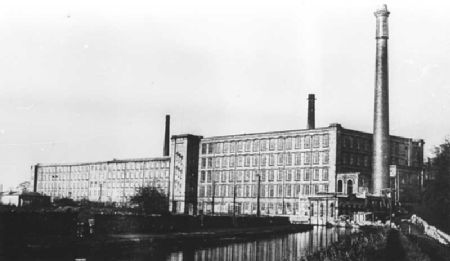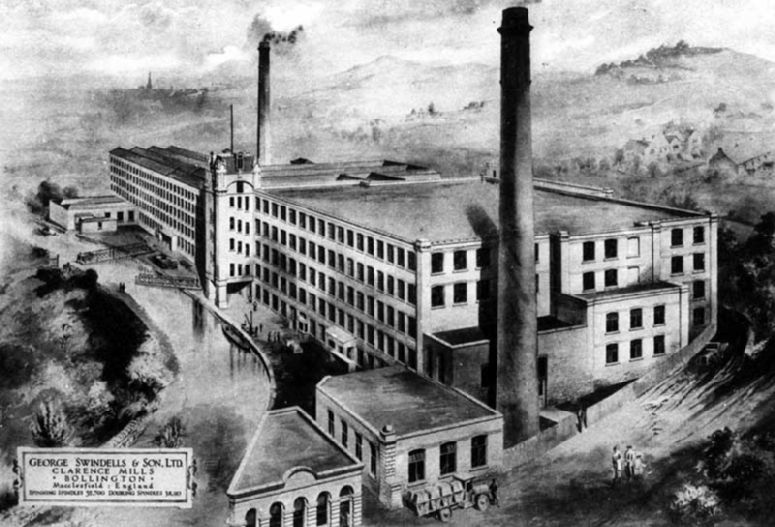
Clarence mill was the first in Bollington to be built for steam power. It was therefore the first to be built away from the river. Indeed, it stands proudly on the hillside over-looking much of the town. It was built here for just one good reason – the canal. The Macclesfield Canal was built between 1826 and 1831, and Joseph Brooke and Martin Swindells I, who were already renting other mills in the town, saw the opportunity to build their own mill (1834-1838) and take a giant leap of advantage ahead of their competitors. Martin was also a Proprietor of the Macclesfield Canal Company. The picture (right) shows the mill in 1920 when there were still three chimneys but before a number of improvements were made to the building.
Transport of raw cotton to Bollington and finished thread and cloth away from Bollington must have been one of the biggest difficulties facing the mill owners in this town. No lorries, no railways, no canal – nothing better than mules and horses to carry the goods upon their backs or on trailers. The roads were very poor so hauling trailers wasn’t really as productive as it might sound. Individual loads on individual animals moved along in trains of half a dozen or more was the best of a bad job.
Brooke & Swindells were determined to maximise their benefit from the canal by building right alongside and to have the mill ready for business in 1838. The first phase of the mill was erected between 1834 and 1838. It stood at the top of a newly built road, Clarence Road, and extended along the canal side about one third along the length of the present mill. Success was marked by an extension further along the canal side in 1841, and in 1857, immediately after completing Adelphi mill, the brothers Martin II and George Swindells extended Clarence again, reaching the limit we see today. In 1877 the first phase was demolished and the present mill, up to the staircase, was built in its place. This was five floors in height and extended away from the canal more than twice the original, making Clarence an altogether enormous mill, much the biggest in Bollington. It was the last cotton mill to be built in East Cheshire.
A number of additional sheds were put up in the space behind the spinning mill. These were for weaving and other activities, but spinning was always the main activity.
The power of steam
Steam provided the power and a boiler house was built behind the original mill. The extensions required more power and an additional boiler house was built, also at the back. In the early 20thC there was a need to modernise the power system, and a new boiler house was built together with a new brick chimney (1914) at the south end of the mill – the chimney is still there and the boiler house was beside it. There were two steam engines, named Success and Perseverance.
The building is constructed of local stone. The floors are vaulted, supported by cast iron beams and pillars, surfaced with stone – a building system known as the fireproof mill. One of the biggest causes of serious fires in old mills was the oil dripping from the machinery which soaked into the timber floors. Unfortunately, oil still got into the stone floors of Clarence mill, and seepage can be seen today in some ceilings.
Later generations
The mill was first built by a partnership of Joseph Brooke and Martin Swindells; Martin Swindells I died in 1843, his son Martin II continued the partnership with Joseph Brooke. Brooke retired and had died by 1872, Martin II retired in 1869 and died in 1880. After Joseph retired, the Brooke family dropped out of the partnership and the enterprise was continued by the brothers Martin II and George Swindells. George died in 1897 having re-established the business of Brooke & Swindells as George Swindells & Son Ltd., and handed the two mills, Clarence and Adelphi, over to his son George Cawley Swindells. In 1891, George Cawley’s son, Geoffrey Hillier Swindells, began at Adelphi and later took charge. In the 1890s, the cotton industry was in decline and many of the mills in Bollington, including Clarence and Adelphi, became, in 1898, part of the Fine Spinners & Doublers Association Ltd. All the resources of the mills were pooled, as well as their supplies and sales. Geoffrey Hillier Swindells answered the call of the nation and served in WWI. He was killed in 1918.

The end of cotton
Spinning ceased by 1970. Luckily the building was saved although for many years it was largely unused. Throughout the first years of the 21stC, more of the building has been brought back into use. The top two floors have been converted into very popular apartments. An additional floor has been created on the roof and a transparent roof has been put over a central atrium. Lower down there are many flourishing small businesses and on the canal side the Café Waterside is a very popular venue. The Civic Society’s Discovery Centre and the Kellico furniture workshop and showroom are also located beside the canal. The weaving sheds at the back of the mill were demolished and a two story car park constructed. A further floor awaits conversion to apartments (2019).
The picture above is of a drawing produced by architects in 1920 showing a birds eye view of the mill after proposed improvements would be made to the building – such as the embellishments to the stair tower. This picture shows a number of interesting features:
- It shows two boiler house chimneys in use. The furthest one was later demolished.
- One can see the immense size of the 1877 re-development of the south (near) end of the mill relative to the original 1841 and 1857 extensions.
- It shows two canal swing bridges. The further one had rails on it and was used to convey boiler ash across the canal to the ash dump where the woodland is today. One can still see the tracks crossing the towpath at this point. The near bridge was a pedestrian bridge which enabled the workers who lived across the valley to cross to the towpath and get to and from the mill without having to descend to the valley bottom and climb up again.
- In the canal is a very unusual double-ended narrow boat. At this time both Clarence and Adelphi mills were in the same ownership and there was a fair amount of material that would have been conveyed between the two. Use of a double-ended horse-drawn boat avoided the need to turn the boat at each end of the journey. Unseen is the horse stable beside the towpath, and there was another at Adelphi.
- Finally, we can see the huge gate houses that controlled access to and from the canal side, designed, no doubt, to ensure that no product was removed from site without proper authorisation and paperwork. In front of the gate house stands a 1920 motor lorry – the first indication of the end of dependence on the canal at Clarence!
Notice that the business is still called George Swindells & Son Ltd. despite the fact that they were a part of the Fine Spinners & Doublers Association Ltd.
Site security – keep the blunderbuss loaded!
The following story comes from a history of the Waterhouse mill …
“A blunderbuss hung on the walls of the [Waterhouse mechanic’s] shop. This weapon was still in its place up to 1900, but about that time it disappeared. Other mills in the village were similarly armed against any attempts on life or property. The use to which it might be put for this purpose may be illustrated by an incident which happened at Messrs. Swindells’ Mill [Clarence or Adelphi]. A new watchman, an Irishman, was engaged and Mr Martin Swindells gave him [among] many other instructions for his night duties; that if he heard any suspicious noises he was to shout three times, ‘Speak, or I’ll shoot’. Mr. Swindells did not quite trust the pluck of the new man, so to test it, he hid himself behind some barrels and packing cases. When the man came round, Mr. Swindells set up a violent commotion in his hiding place. The Irishman yelled out ‘Shoot or I’ll Shout three times’ and let go in the direction of the noise. It was fortunate that Mr. Swindells was well hidden so he escaped injury.”
Acknowledgements
Our thanks go to those who researched and discovered the history that is presented in these pages. Please read the full acknowledgement of their remarkable achievement. Unless otherwise noted, the historical pictures are from the Civic Society picture collection at the Discovery Centre and also available online![]() .
.
Probably the best history of Bollington’s cotton mills may be found in the book East Cheshire Textile Mills, written by Anthony Calladine and Jean Fricker, published by the Royal Commission on the Historical Monuments of England, 1993.
Your Historic Documents
Please don't chuck out those historic documents and pictures! Find out why here.